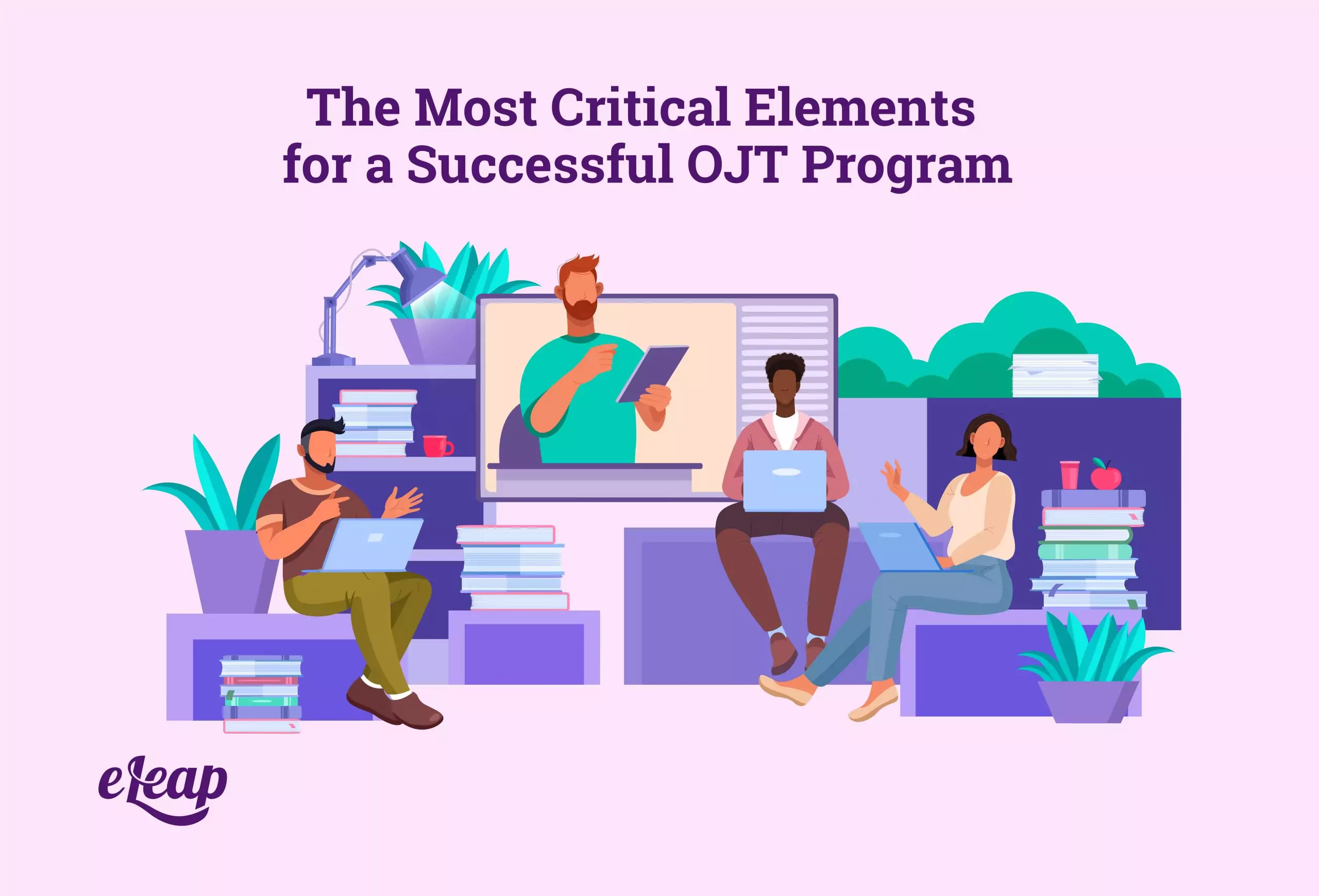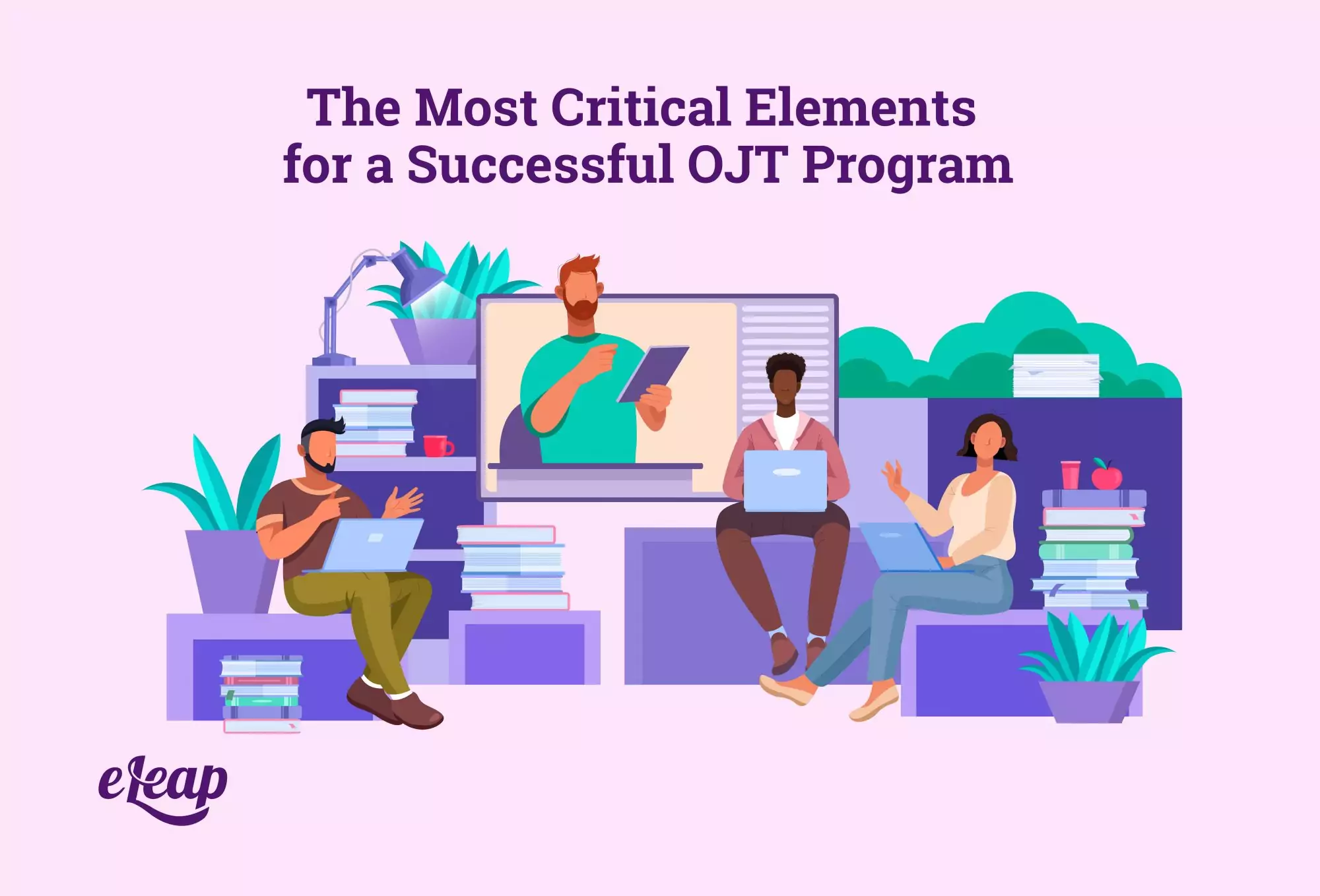The Most Critical Elements for a Successful OJT Program

On-the-job training, usually abbreviated as OJT, is one of the most important tools in your L&D arsenal. For most human beings, it is how we learn best (hands-on, involved in the process, and led by an experienced instructor). Additionally, there are many benefits to be gained by instituting a successful OJT program within your organization.
With that being said, it can be challenging to ensure that your program is successful. Many factors can devalue the program, lead to unexpected (and unwanted) outcomes, and even decrease learner enthusiasm and ability to learn what is being taught. Unsure how to create a successful OJT program? In this post, we will explore some of the most critical elements. Get a 15-minute free consultation to learn how the eLeaP system can help you deliver a successful OJT program.

Know the Outcomes That Matter
What is the desired outcome of your OJT program? Without understanding what you want employees to achieve, you will have no way of measuring their progress toward it or even knowing when they achieve the outcome. So, the first thing to consider when designing an OJT program is what you want employees to get out of it.
This could be virtually anything, from a defined single skill to a collection of capabilities to something less easily defined, such as a series of soft skills improvements. However, it’s not enough to set a goal. You must also connect training outcomes with work requirements and then document everything so that both trainees and trainers understand.
Clarity in Terms of Goals and Planning
It is not enough to understand the desired outcomes and then tie those to work requirements. You must also set clear goals and create an easy-to-follow plan that takes learners and trainers from point A to point Z. Your training should be thoughtfully designed and structured so that both trainers and trainees can understand the experience from beginning to end.
Think of it this way: your plan and goals should form a map that lets those involved in the training process see where they are, where they want to go, and how they will get there. It’s about providing clarity and understanding, as well as a guiding hand to encourage progress toward meaningful results. Without such a plan, both trainers and trainees are essentially flying blind. They know what they need to achieve, but it’s unlikely that they really understand how to get there.
Don’t Leave OJT Unstructured
There’s a temptation to let OJT efforts remain loosely structured. For instance, you might have a new employee shadow a more seasoned worker as they go about their daily responsibilities. The ostensible goal here is that the shadowing worker will learn from observing, as well as limited hands-on experience. However, the lack of structure in this situation may actually be doing more harm than good.
Without structure, both trainers and trainees lose focus. It becomes difficult to understand expectations when they are not clearly stated (in the form of structure). How do you avoid this pitfall? Follow today’s instructional design best practices when it comes to creating program elements, including content and practice. Make sure to provide opportunities for feedback for the employee, as well as from the employee to the trainer and from both trainer/trainee to management.
The Right Materials Are Critical
Too often, OJT is seen as needing little, if any, support from materials. The truth is that all successful OJT programs benefit from professionally-created materials that help guide learners and trainers. Note that both trainers and trainees require this type of support.
Ideally, both trainer and trainee will have access to the same materials. This ensures that everyone is on the same page and helps to avoid knowledge gaps while providing guidance and support where it’s needed most. What sorts of materials might you need, though?
You might choose to provide any of a wide range of support materials, from handbooks to job descriptions and training cards to process overviews. They should be kept in an easily accessed location and may be physical or digital in nature. If going the digital route, a simple solution is to make them accessible via your learning management system.
Pay Attention to Coach Selection
Anyone can be a coach when it comes to on-the-job training. You can empower an employee’s coworkers to provide OJT opportunities, ranging from basic instruction to job shadowing. However, managers and other leaders can (and arguably should) take a hand in coaching and training. You can also choose to bring in trainers from outside the company.
Of these options, an in-house trainer is the better option. These people, whether employees or managers, will be intimately familiar with your organization’s story, your brand, your audience, and other factors. Outside trainers might have the knowledge to impart, but without that deep connection with your organization, they are less effective.
Get a 30-day free trial of eLeaP and see how easy it is to deploy a successful OJT program.